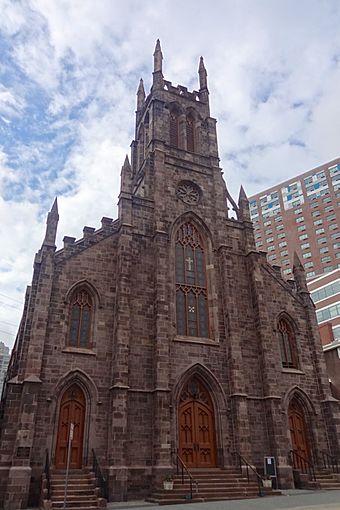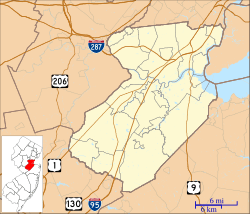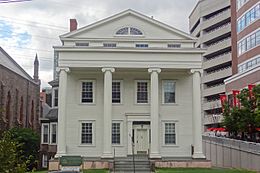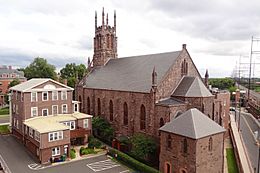Saint Peter the Apostle Church facts for kids
|
Saint Peter the Apostle Church
|
|
 |
|
| Location | 94 Somerset Street, New Brunswick, New Jersey |
|---|---|
| Area | 0.9 acres (0.4 ha) |
| Built | 1865 |
| Architect | Keely, Patrick Charles; O'Rourke, Jeremiah, et al. |
| Architectural style | Gothic Revival, Greek Revival |
| NRHP reference No. | 05001332 |
Quick facts for kids Significant dates |
|
| Added to NRHP | November 25, 2005 |
Saint Peter the Apostle Church is a historic Roman Catholic church located at 94 Somerset Street in New Brunswick, Middlesex County, New Jersey, United States. It is a very old and important building.
The first Catholic church in New Brunswick was called St. Peter's. It was built in 1829 on Bayard Street and mostly served Irish Catholic families. The church building you see today was finished in 1865. It was added to the National Register of Historic Places on November 25, 2005. This was because of its beautiful and important architecture.
Contents
History of Saint Peter's
Early Beginnings
The first time a Catholic priest visited New Brunswick was in 1825. A priest named Father McDonough stopped there while traveling. Later that year, Father John Powers from New York City began visiting monthly. He held Mass, which is a church service, first in a home and then in a large room above a shop.
In 1829, Bishop John Dubois sent Father Joseph Schneller to continue these monthly visits. Bishop Dubois officially created St. Peter & Paul Parish in 1829. A simple brick church was built on Bayard Street in 1831. It was not easy to get the land for the church because some people were against Catholics at the time. Father Schneller had to be very clever to get the land.
First Resident Pastors
In 1833, Father Bernard McArdle became the first priest to live in New Brunswick and serve the church full-time. During his time, a big tornado hit New Brunswick on June 19, 1835. It partly damaged the church, but people still used it after it was fixed up with boards.
Father John Rogers became the first permanent priest in 1845. He was from Ireland and came to America to become a priest. Father Rogers is seen as the "founding pastor" of St. Peter's as we know it today. He saved the church building from being taken away due to debt. He also repaired and made it bigger. He even built the first school for the parish.
Building a New Church
As New Brunswick grew and more Catholic families moved in, Father Rogers did even more. He often traveled to nearby towns to hold church services. St. Peter's became known as the "Mother Church" for many Catholic communities in Central Jersey.
In 1853, land was bought for a new, larger church on Somerset Street. This was right across from Rutgers College. A famous Irish-American church architect named Patrick Charles Keely was hired to design a grand new church. The current church was built between 1854 and 1865. The first part, the lower church, was finished in 1856.
In 1870, a beautiful set of bells was put in the church. These bells are very special and are still played on important holidays. A room for priests to prepare for services, called a sacristy, was added in 1891. The marble altar and decorations were put in in 1919. The stained-glass windows were replaced in 1950. In 1999, a new electronic organ was installed.
Rectory and Convent
The St. Peter's Rectory is a beautiful old building. It was built before the church bought the Somerset Street property. It has been the home for every priest who has served St. Peter's for over 150 years. Today, priests and brothers who serve the church and Catholic students at Rutgers University live there.
In 1867, a group of nuns called the Sisters of Charity came to work at the parish school. A convent, which is where the sisters lived, was built next to the new church. The convent was made bigger several times to fit more sisters. Sisters lived there until 2004. After being fixed up, the convent building reopened in 2010. It is now a center for Catholic students at Rutgers University.
Schools and Hospital
In 1892, a new parish school called Columbia Hall was built. Later, a new elementary school with a gym was built in 1960. A new high school replaced Columbia Hall in 1970. St. Peter the Apostle High School closed in 2007 because fewer students were attending. The elementary school also closed in 2010. The church is still looking for new ways to use these school buildings.
St. Peter's Hospital started from the parish in the 1860s. It moved to its current location in the 1920s. The hospital has grown a lot and is now the only Catholic hospital in the area.
Modern Updates and Future
In 1991, the basement church was changed into a parish hall. It was renovated again in 2010-2011. This space is now used by the church and the university students. New church offices were also added there. These new offices and the parish hall opened in December 2011.
St. Peter the Apostle Parish celebrated its 175th anniversary in 2004. In 2005, the Church, Rectory, and Convent were recognized as historic places. Today, the church is working on a big project to restore these beautiful buildings. This will make sure they are safe and welcoming for many more years.
St. Peter's Parish is still a very active and important part of Catholic life in New Brunswick. It has been for over 175 years and continues to be a central place for the community. The church is also known for having excellent historical records for the Diocese of Metuchen.
Gallery






